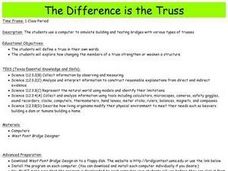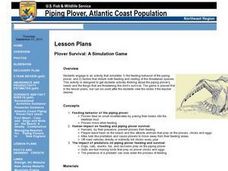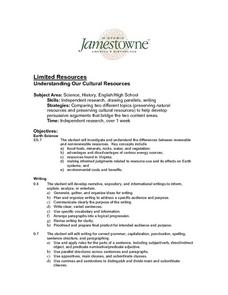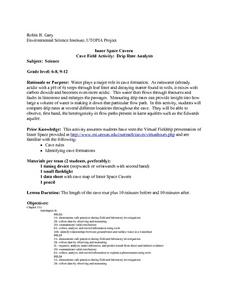Curated OER
Can You Tell By Touch?
Students feel inside a bag and use only their sense of touch to describe and identify one of the objects that is inside the bag.
Curated OER
Can You Match Them?
Students find pairs of matching sounds by shaking lidded containers and listening to the sounds that are generated.
Curated OER
Galloping Who?
Third graders do an Internet search to find out about Galloping Gertie and what caused the bridge to fail.
Curated OER
The Difference is the Truss
Students use a computer to simulate building and testing bridges with various types of trusses.
Curated OER
Build and Test
Students display what they have learned about bridges as they construct their bridge. They present their projects to the rest of the class. They compare and contrast the construction of the bridges.
Curated OER
Escape! Survival of the Fittest Grasshopper
Fourth graders, in groups, design a paperclip grasshopper. They determine its ability to survive a prey by jumping high, far, or with a distracting behavior.
Curated OER
Our Class Record Book
Second graders, in groups, prepare a list of proposed record ideas for the class book.
Curated OER
Million Dollar Gift
Third graders create a box big enough to hold a million dollars. This is a project fun to do near the winter holidays with inexpensive gifts included in the boxes. This hands-on lesson very effectively demonstrates the concept of volume.
Curated OER
Va Va Va Zoooommm
High schoolers, in groups, measure a variety of physical components to several activities. They use both standard and non-standard forms of measurement and then develop conclusions about the use of units in measurement.
Curated OER
Plover Survival: A Simulation Game
Seventh graders engage in a simulation that explains the feeding behavior of the piping plover and the things that disturb the feeding and nesting of this species.
Curated OER
Adaptable Mandibles
Students define adaptation and highlight example of adaptation in birds and other animals. They study feeding techniques of seabirds and investigate the effect that trash has on wildlife.
Curated OER
Imagery
Young scholars listen to poetry and discuss the imagery. They write a creative poem demonstrating imagery. They write about imagery of a picture and visit a website to read poetry tips. They evaluate poetry using an evaluation form.
Curated OER
Walk a Mile in Albatross Shoes
Students recognize the correlation between the trash they dispose of around their school and the environmental hazards that face wildlife, specifically the Laysan albatross. They determine three ways that they can help the albatross chicks.
Curated OER
The Transformation and Use of Different Types of Energy Using Local Flora and Fauna in a Vietnam Village Setting
Eighth graders examine the concept that the sun is the ultimate source of energy for living things. They conduct an experiment in which they roast marshmallows over a flame that has been produced from methane gas, which originates from...
Curated OER
Making The Height
Twelfth graders apply estimation techniques to determine how high any one basketball player can jump.
Curated OER
Art or Artifact?
Students analyze and discuss illustrations of the New World by John White. They examine the images, answer questions about each one, and write an essay.
Curated OER
Limited Resources - Understanding Our Cultural Resources
Learners examine and compare preserving natural resources and preserving cultural resources. They conduct Internet research on two topics, and write a position paper on whether cultural resources or natural resources are more important...
Curated OER
Inner Space Cavern Cave Field Activity: Drip Rate Analysis
Students compare drip rates at several different locations throughout a cave. They observe, first hand, the heterogeneity in flow paths present in karst aquifers such as the Edwards aquifer.
Curated OER
What Kind of Insect is That?
Fifth graders characterize insects and classify insects according to the Linnaean system. They use hand lenses or microscopes to examine insect body parts.
Curated OER
Insect Matching
Third graders match insects to the proper order based on the characteristics. They culminate their study of the orders that insects belong in by looking at insects with magnifying glasses.
Curated OER
Insects: Listen and Learn
Fourth graders use their listening skills to make observations of their environment. They study various insects within a natural setting. They, along with their identification of the insect, create a sketch of the insect.
Curated OER
The Transit in Pictures
Students investigate the Transit of Venus and create and produce a public service commercial promoting the Transit of Venus and providing information about its safe viewing.
Curated OER
My Country at the Crossroads to Peace
Students discuss issues with regard to different ways their countries are affected at the cross roads to world peace. They write prose pertaining to issues relating to unpeaceful situations in the world.
Curated OER
Be Ready, Be Safe
Middle schoolers complete a variety of activities as they explore the Canadian Red Cross emergency preparedness program for youth, ages 12-13.
Other popular searches
- Indirect Characterization
- Direct and Indirect Objects
- Indirect Measurement
- Indirect Proofs
- Indirect Objects
- Indirect Object Pronouns
- Direct Indirect Speech
- Indirect Speech
- Direct and Indirect Speech
- Indirect Evidence
- Indirect Quotations
- Math Indirect Measurement

























